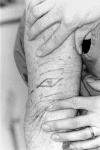Skin biopsy techniques for the internist
- PMID: 9462495
- PMCID: PMC1496896
- DOI: 10.1046/j.1525-1497.1998.00009.x
Skin biopsy techniques for the internist
Abstract
Objective: To review three commonly performed skin biopsy procedures: shave, punch, and excision.
Data sources: English-language articles identified through a MEDLINE search (1966-1997) using the MeSH headings skin and biopsy, major dermatology and primary care textbooks, and cross-references.
Study selection: Articles that reviewed the indications, contraindications, choice of procedure, surgical technique, specimen handling, and wound care.
Data extraction: Information was manually extracted from all selected articles and texts; emphasis was placed on information relevant to internal medicine physicians who want to learn skin biopsy techniques.
Data synthesis: Shave biopsies require the least experience and time but are limited to superficial, nonpigmented lesions. Punch biopsies are simple to perform, have few complications, and if small, can heal without suturing. Closing the wound with unbraided nylon on a C-17 needle will enhance the cosmetic result but requires more expertise and time. Elliptical excisions are ideal for removing large or deep lesions, provide abundant material for many studies, and can be curative for a number of conditions, but require the greatest amount of time, expertise, and office resources. Elliptical excisions can be closed with unbraided nylon using a CE-3 or FS-3 needle in thick skin or a P-3 needle on the face. All specimens should be submitted in a labeled container with a brief clinical description and working diagnosis.
Conclusions: Skin biopsies are an essential technique in the management of skin diseases and can enhance the dermatologic care rendered by internists.
Figures




Comment in
-
A biopsy is more than a biopsy.J Gen Intern Med. 1998 Jan;13(1):62-3. doi: 10.1046/j.1525-1497.1998.00042.x. J Gen Intern Med. 1998. PMID: 9462499 Free PMC article. No abstract available.
References
-
- Wigton RS, Blank LL, Nicholas JA, Tape TG. Procedural skills training in internal medicine residencies. A survey of program directors. Ann Intern Med. 1989;111:932–8. - PubMed
-
- Fitzpatrick TB, Bernhard JD. The structure of skin lesions and fundamental of diagnosis. In: Fitzpatrick TB, Eisen AZ, Wolff K, Freedburg IM, Austen KF, editors. Dermatology in General Medicine. 3rd ed. New York, NY: McGraw-Hill; 1987. p. 47. In. eds.
-
- Pariser RJ. Skin biopsy: lesion selection and optimal technique. Mod Med. 1989;57:82–90.
-
- Pinkus H. Skin biopsy: a field of interaction between clinician and pathologist. Cutis. 1977;20:609–14. - PubMed
-
- Arca MJ, Bierman JS, Johnson TM, Chang AE. Biopsy techniques for skin, soft-tissue, and bone neoplasms. Surg Oncol Clin North Am. 1995;4:157–74. - PubMed
Publication types
MeSH terms
LinkOut - more resources
Full Text Sources
Other Literature Sources
Medical
